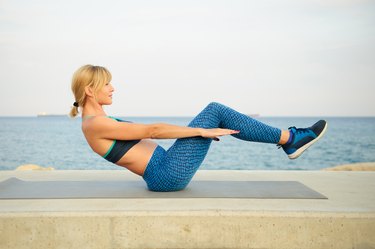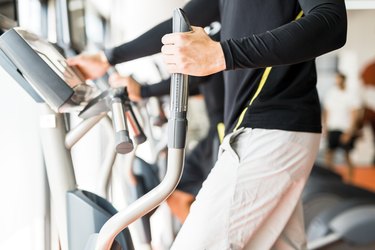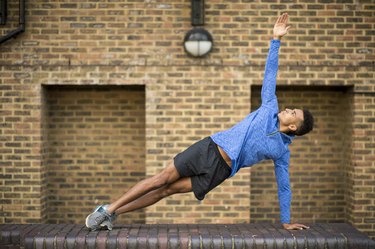
As great as high-intensity interval training (HIIT) is — revving your cardiovascular health, building muscle, torching calories and helping to cut your risk of chronic disease in record time — it gets a bad rap for being hard on your joints. It's time to set things straight.
"'High-intensity' and 'high-impact' exercise are not synonymous," says Layne Nordquist, C.P.T., a master trainer with VASA Fitness in Denver, CO. "When we talk about intensity, we are really just trying to describe how hard you're working. You can work hard without putting a lot of impact on your body through running or jumping."
Video of the Day
Video of the Day
Benefits of Low-Impact HIIT Workouts
For beginners as well as older adults, one consideration when it comes to impact activities is joint strength, says Garrick Lim, a physical therapist and kinesiologist with REACT Physical Therapy in Chicago.
He explains that when the muscles that support a joint don't have the necessary amount of strength, high-impact activities such as squat jumps and bounding can put too much stress on the ligaments, tendons, cartilage and even bone that make up the joint, contributing to both acute pain and gradual wear-and-tear issues.
Even workout veterans who are rehabilitating an injury can benefit from low-intensity as a way to let the tissues heal and avoid re-injury, Lim says.
Easy Low-Impact HIIT Modifications
Fortunately, it's not hard to make high-intensity exercise low-impact. "For most people, changing any exercise in which your feet leave the floor to an exercise in which your feet remain in contact with the ground at all times will do the trick," says Mauro S. Maietta, AFAA certified personal trainer and district fitness manager at Crunch.
"Turn jumping exercises into similar lower-body strengthening exercises with an upper body component to force your heart rate up higher and work your entire body harder," he says. "And think outside of running for cardiovascular intervals."
To get you started on the right, low-impact foot, we've assembled six high-intensity workouts that will increase your heart rate, burn some serious calories and build all-over muscle — no jumping or jolting required.
Read more: A 35-Minute HIIT Workout That Won't Hurt Your Knees

Low-Impact HIIT Workout #1: Circuit Strength
Resistance training circuits are ideal for building functional strength while also getting a great cardiovascular workout. This five-move circuit requires a single set of light dumbbells and prioritizes compound, full-body moves to give you the biggest bang for your buck possible, Maietta says.
To complete it, perform 12 reps of each exercise, rest for 30 seconds, and then repeat the circuit for a total of two to three rounds.
- Squat to shoulder press
- Side lunge to triceps kickback (6 on each side)
- Reverse lunge to biceps curl (6 on each side)
- Bent-over dumbbell row
- Dumbbell chest press
Low-Impact HIIT Workout #2: 30/30 Rowing Speed Intervals
Rowing is an exceptional cardiovascular exercise that skirts the line of go-hard strength training by working muscle groups from head to toe. Plus, with your glutes on the seat and your feet strapped in tight, you expose your body to minimal impact, Lim says.
- 5-minute easy warm-up
- 5 minutes of 30-second high-intensity intervals (max for 30 seconds, easy for 30 seconds)
- 5-minute easy cool down
Low-Impact HIIT Workout #3: Indoor Cycling Ladders
Cycling is a favorite low-impact activity that can leave your legs burning like nothing else. And the great thing about using an indoor bike to perform intervals is that it offers two ways to vary intensity: speed and resistance, says Lim.
This 10-minute ladder workout harnesses both to help you build strength, endurance and speed all at once. Just make sure you warm up before and cool down after.
- 1 minute fast speed, light resistance
- 1 minute medium speed, medium resistance
- 1 minute slow speed, high resistance
- 1 minute medium speed, medium resistance
- 1 minute fast speed, light resistance
- 1 minute medium speed, medium resistance
- 1 minute slow speed, high resistance
- 1 minute medium speed, medium resistance
- 1 minute fast speed, light resistance
- 1 minute medium speed, light resistance

Low-Impact HIIT Workout #4: Elliptical Intensity
The elliptical is a common substitute for those wanting a run-like workout without pounding the pavement or treadmill. Since your feet never leaving the pedals, the elliptical is a great example of how any movement pattern can be made low intensity: never go airborne.
This 15-minute elliptical interval workout uses both speed and resistance level to vary intensity and schedule in "rest" before asking you to give your all with fast-paced, high-resistance periods of all-out effort.
- 2 minutes slow speed, light resistance
- 1 minute fast speed, high resistance
- 1 minute medium speed, medium resistance
- 2 minutes slow speed, light resistance
- 1 minute fast speed, high resistance
- 1 minute medium speed, medium resistance
- 2 minutes slow speed, light resistance
- 1 minute fast speed, high resistance
- 1 minute medium speed, medium resistance
- 2 minutes slow speed, light resistance
Low-Impact HIIT Workout #5: Treadmill Incline Walking Intervals
"Instead of a fast sprint on the treadmill, crank up the incline," Maietta says. Doing so will allow you to walk, not run, meaning one foot will be on the treadmill at all times. To keep things simple, this 20-minute walking workout involves maintaining a steady pace throughout. All you have to do is put one foot in front of the other — adjusting incline as you go.
No matter the incline, it's important to keep your hands off of the railing. No hanging on it! If at any time you find yourself unable to maintain an upright posture without using the railing, lower your incline and/or speed.
- 3 minutes at incline 2
- 2 minutes at incline 5
- 2 minutes at incline 2
- 2 minutes at incline 7
- 1 minute at incline 10
- 2 minutes at incline 2
- 2 minutes at incline 5
- 2 minutes at incline 2
- 2 minutes at incline 7
- 1 minute at incline 10
- 2 minutes at incline 2

Low-Impact HIIT Workout #6: Isometric Strength Supersets
By now, you probably have a pretty good idea of why high-intensity workouts don't need to be high-impact. But, get this: You don't even have to move to get in a high-octane sweat session, Nordquist says. That's because isometric exercises (holding the same position for a given amount of time) are incredibly challenging, building strength, control and stability while getting your heart moving in a big way.
The key when performing isometric exercises is to build full-body tension. Put another way, squeeze every muscle you've got! Doing so will increase muscle activation.
This total-body isometric HIIT workout is set up in three supersets, each comprised of two exercises that should be performed back-to-back without rest. Perform three to four rounds of each superset before resting for 30 to 90 seconds, and then moving on to the next superset.
- 15 to 30 seconds hollow-body hold
- 60 seconds wall sit
- Repeat for 3 to 4 rounds
- 30 to 90 seconds rest
- 30 to 60 seconds side plank (15 to 30 seconds/side)
- 60 seconds glute-bridge hold
- Repeat for 3 to 4 rounds
- 30 to 90 seconds rest
- 60 seconds lunge hold (30 seconds each side)
- 60 to 90 seconds Downward-Facing Dog
- Repeat for 3 to 4 rounds
- 30 to 90 seconds rest